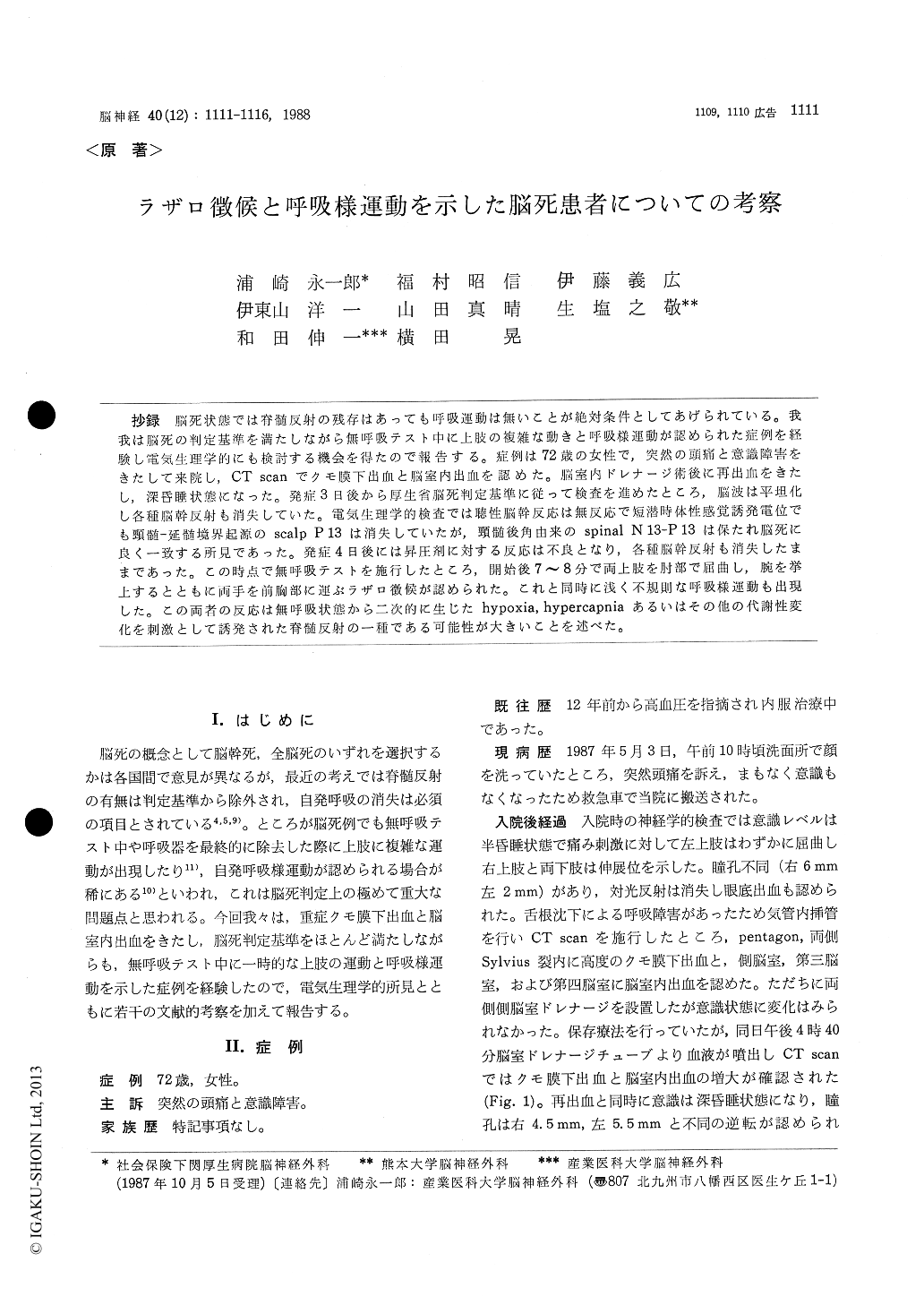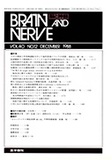Japanese
English
- 有料閲覧
- Abstract 文献概要
- 1ページ目 Look Inside
抄録 脳死状態では脊髄反射の残存はあっても呼吸運動は無いことが絶対条件としてあげられている。我我は脳死の判定基準を満たしながら無呼吸テスト中に上肢の複雑な動きと呼吸様運動が認められた症例を経験し電気生理学的にも検討する機会を得たので報告する。症例は72歳の女性で,突然の頭痛と意識障害をきたして来院し,CT scanでクモ膜下出血と脳室内出血を認めた。脳室内ドレナージ術後に再出血をきたし,深昏睡状態になった。発症3日後から厚生省脳死判定基準に従って検査を進めたところ,脳波は平坦化し各種脳幹反射も消失していた。電気生理学的検査では聴性脳幹反応は無反応で短潜時体性感覚誘発電位でも頸髄—延髄境界起源のscalp P 13は消失していたが,頸髄後角由来のspinal N 13—P 13は保たれ脳死に良く一致する所見であった。発症4日後には昇圧剤に対する反応は不良となり,各種脳幹反射も消失したままであった。この時点で無呼吸テストを施行したところ,開始後7〜8分で両上肢を肘部で屈曲し,腕を挙上するとともに両手を前胸部に運ぶラザロ徴候が認められた。これと同時に浅く不規則な呼吸様運動も出現した。この両者の反応は無呼吸状態から二次的に生じたhypoxia, hypercapniaあるいはその他の代謝性変化を刺激として誘発された脊髄反射の一種である可能性が大きいことを述べた。
In the diagnosis of brain death, it is generally accepted that respiratory function has to be absent, however, spinal reflexes can be preserved. Wepresented a patient who showed a complex move-ments of upper limbs (Lazarus' sign) and res-piratory like movement during the apnea test for the determination of brain death. This 72-year old female admitted to our hospital in a semi-comatous state due to severe subarachnoid and ventricular hemorrhage. Her conscious level sud-denly deteriorated to deep coma because of second hemorrhage on the same day. She became apnea and no brain stem reflexes elicited. Three days later, electrophysiological examination revealed a flat recording of electroencephalography, absence of auditory evoked potentials and no response of blink reflex. Short latency somatosensory evoked potentials obtained by median nerve stimulation showed the presence of Erb's N9 and spinal N 13-P 13 components originating from cervical dorsal horn, however, the scalp P 13 generated by cervico-medullary junction was absent. This patient fulfilled all other criteria for brain death. Four days after, an apnea test was performed. Spontaneous movements of both upper limbs wereobserved starting between 7 and 8 minutes after disconnecting the intubation tube from the venti-lator. Both arms flexed at the elbow, abducted and elevated from the bed. Then, both hands were brought up to chest. Wrist and fingers were in a neutral position (Lazarus' sign). Simultaneous-ly, shallow and irregular respiration like move-ments were recognized. These movements ceased immediately after connecting the respirator. These two types of movements were reproducible except for in the final test. Blood pressure gradually decreased, and cardiac arrest occurred one hour after. The mechanism of Lazarus' sign and res-piratory like movements were discussed. SSEP findings suggested that these movements were ori-ginated from spinal level rather than brain stem. It was considered that they were elicited by the spinal reflexes induced by hypoxia, hypercapnia or other metabolic factors during apnea. Atten-tion has to be paid that such complex spinal re-flexes could appear in the condition of brain death.

Copyright © 1988, Igaku-Shoin Ltd. All rights reserved.


